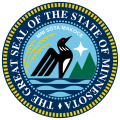| |||||||||||||||||
| |||||||||||||||||
| |||||||||||||||||
The 1867 Minnesota lieutenant gubernatorial election was held on November 5, 1867, in order to elect the lieutenant governor of Minnesota. Republican nominee and incumbent lieutenant governor Thomas H. Armstrong defeated Democratic nominee Arba Maynard. [1]


